A man, a plan, a canal: Panama
Thanks for your well-wishes! I'm feeling better, mostly (or else I wouldn't be typing this). Thankfully it's been a short and relatively merciful little bug.
I'm on the decreases of the Clapster, and should have my first FO of 2007 in a day or two, as well as a bit of parrot sock!
Also... I (and a host of other apparently deprived knitters) won some Socks That Rock yarn from Cara's contest at January One! Yes, I'm a STR Virgin, along with, oh, about 800 other commenters. (And no, this doesn't break my yarn diet since I didn't spend a penny and anyways, it's for a good cause, supporting the makers of yummy sock yarn in the faces of those who can't believe so many people want to knit socks.)
Panama in photos and words (picture-heavy, just to warn you)
As I mentioned in the previous post, we stayed with my relatives while we were there. They're ex-pats, living half the time in Panama and half the time in Washington State. They've lived in Panama for approximately a year now, with comparatively little time in the States. For me, this is the first time I've had family living overseas (while I've been alive, that is... my parents lived overseas before I was born). Thus, I kind of forgot to brush up on the little Spanish I remember from elementary school or to think about much having to do with international travel except the need for a passport. We're visiting family, so what could be different?
Obviously, there's the canal. I've never been terribly into machinery. Sure, it's interesting. But there's something about seeing ginormous boats pass through a sliver of water that seems to captivate people's attention, including mine. We'd stop along the highway to watch a Panamax - ships just as wide as the canal - pass through, before heading home. A nice restaurant sits next to another set of locks, Miraflores, just so people can watch the ships pass through. 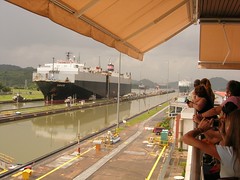
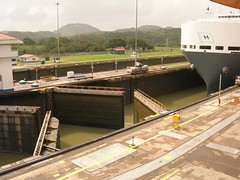
The human historical landscape of Panama has much to recommend it other than the canal, of course. We didn't make it to any pre-Columbian sites, but we did see the main centers of Panama's Spanish heritage. Panama Viejo ('Old Panama') the first Spanish settlement, was destroyed by Cap'n Henry Morgan (arrrgh!) in 1671. Today, the old church square sports a life-size replica of the manger scene, wise men, camels and, of course (this is a knitting blog, after all) - sheep! They weren't very wooly, though. 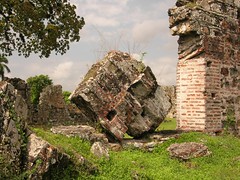
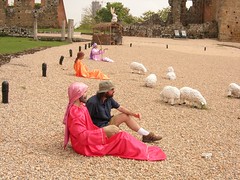
After Morgan's sack, the city moved a few miles away to what's now called "Casco Viejo," the Old Helmet, referring to the shape of the land. 
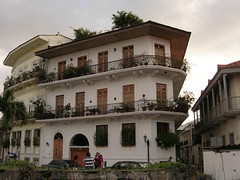
Today, of course, Panama City has spilled out of the former bounds of "the helmet" and now sports a bustling metropolis complete with an increasing number of sky-scrapers. 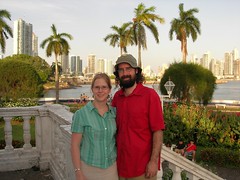

As I've mentioned (several times) before, Panama is tropical, hot, and humid, and that means interesting flora and fauna everywhere one looks. Our host Jen could tell you more about the incredible natural bounty found in Panama, especially the birds, which she's become fascinated by. Coffeeboy and I didn't quite share the fascination with birds, but we found the flora to be quite beautiful. The weather in Panama is approximately the same year-round, we hear, around the 80s-90s, allowing for gorgeous flowers pretty much all the time. Coffeeboy takes excellent macro photos of flowers, doesn't he?
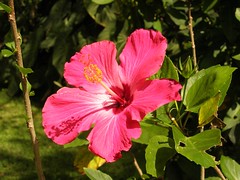
Fruits and vegetables flourish in Panama's temperate climate, too. Did you know you can buy a fresh pineapple for 75 cents? Or Panamanian coffee for as low as $2.10 a pound? We brought home a 5-lb bag of beans that cost only $12.40!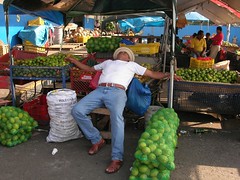
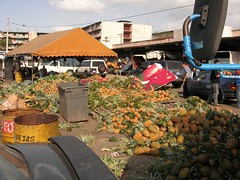
Everywhere, it seems, there's jungle, crowding up next to the cities. The canal zone relies on the jungle as a watershed to keep it functioning, so much of the region around the canal, near where we stayed, has been turned into national parks for protection of the jungle. 
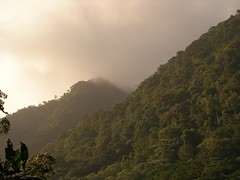
None of these things, however, are really all that unexpected. What we found to be most different about this trip was the view afforded by staying with residents, with ex-pats. First of all, we saw a very small slice of ex-pat life, the close social network that can form where the most you might share is a home country, and that's somehow enough.
The second difference had more to do with not staying in a hotel than with who we met. I expect that had we stayed in a hotel, it would have felt much more like any other overseas journey - and it would been much less of an adventure. Our hosts live, for now, in a middle-class Panamanian neighborhood in a typical house. (They're building a new home and renting this one). We learned that despite being hot and humid, Panama isn't like Texas or Florida in that one can't take air-conditioning (in extremely cold or even just moderate forms) for granted.
Despite being perfectly potable (unlike water in other third-world countries, for example) the water doesn't necessarily run all the time; we woke up several mornings to a lack of running water that lasted through the evening. One day the water was out and we had a few electrical outages as well, for reasons unknown. I told Coffeeboy, "Think of it like indoor camping: it's hot, there's no AC, and we're not sure when we're going to shower next!" Panamanians, it seems, don't routinely have hot water heaters. Our hosts will have hot water at their next house, but for the time being, we got ... somewhat... used to tap-water cool showers. Not frigid showers, as the pipes never got cold enough for that, but cool nonetheless.
Annoyances sometimes, these little cultural differences, above and beyond the canal and the flourishing flora and fauna, made for a truly fascinating trip. You can see a few more of our photos here at my Flickr site.





4 comments:
Wow, it's looks beautiful there (despite the lack of water and a/c). One of my best friends is heading there next month, so it's even more exciting to get an idea of what is out there
Two thoughts. One: It maakes sense that Jen is fascinated by Panamanian birds. She tried to teach me how to identify lots of impressive birsd in the Pacific Noprthwest. (It did not work. I did not learn. But I loved having them shown to me.) Two: Coffeeboy, if you read this, will you teach me to photograph flowers?
Great photos! I'm glad you had a great time
Glad you liked my flower pictures, dear Lazuli. :)
Greta Jane - It's really easy to photograph flowers! If you have a point-and-click camera, just make sure that you have macro mode turned on and that the little LCD preview screen actually shows the focus. Play with the focus until you have the flower in focus, then move the frame around (and the zoom, if you need to) until you have it the way you want it.
--coffeeboy
Post a Comment